OpenID Connect#
Protocol Overview#
OpenID Connect is an identity layer that profiles and extends OAuth 2.0. It defines a sign-in flow that enables an application (client) to authenticate a person, and to obtain authorization to obtain information (or "claims") about that person. For more information, see http://openid.net/connect
It's handy to know some OpenID Connect terminology:
-
The end user or subject is the person being authenticated.
-
The OpenID Provider or OP is the equivalent of the SAML IDP. It holds the credentials (like a username/ password) and information about the subject. The Gluu Server is an OP.
-
The Relying Party or RP or client is software, like a mobile application or website, which needs to authenticate the subject. The RP is an OAuth client.
Note
To learn more about the differences between OAuth, SAML and OpenID Connect, read this blog.
Gluu Server OpenID Connect Provider (OP)#
The Gluu Server passes all OpenID Provider conformance profiles and supports the following OpenID Connect specifications: Core, Dynamic Client Registration, Discovery, Form Post Response Mode, Session Management, and the draft for Front Channel Logout.
OpenID Connect APIs#
Review the Gluu Server's OpenID Connect API endpoints in the API Guide.
OpenID Connect Flows#
The Gluu Server supports all flows defined in the Core spec, including implicit, code, and hybrid flows. The implicit flow, where the token and id_token are returned from the authorization endpoint, should only be used for applications that run in the browser, like a Javascript client.
The code flow or hybrid flow should be used for server side
applications, where code on the web server can more securely call
the token endpoint to obtain a token. The most useful response type
for the hybrid flow is "code id_token". Using this flow, you can verify
the integrity of the code by inspecting the c_hash claim in the
id_token.
If you are using the code flow, the response type should only be code. There is no point in using response type "code token id_token"--the extra tokens returned by the authorization endpoint will only create additional calls to the LDAP server and slow you down. If you are going to trade the code at the token endpoint for a new token and id_token, you don't need them from the authorization endpoint too.
| Step | Authorization code flow | Implicit flow | Hybrid flow |
|---|---|---|---|
| 1 | User accesses an application. | User accesses an application. | User accesses an application. |
| 2 | The application/relaying party (RP) prepares an authentication request containing the desired request parameters and sends it to the OpenID Provider (Gluu Server). The response_type requested is code. |
The application/replaying party (RP) prepares an authentication request containing the desired request parameters and sends it to the OpenID Provider (Gluu Server). The response_type requested is id_token or id_token token. |
The application/replaying party (RP) prepares an authentication request containing the desired request parameters and sends it to the OpenID Provider (Gluu Server). The response_type requested is code id_token, code token, or code id_token token. |
| 3 | The OpenID Provider (Gluu Server) verifies the user’s identity and authenticates the user. | The OpenID Provider (Gluu Server) verifies the user’s identity and authenticates the user. | The OpenID Provider (Gluu Server) verifies the user’s identity and authenticates the user. |
| 4 | The OpenID Provider (Gluu Server) sends the user back to the application with an authorization code. | The OpenID Provider (Gluu Server) sends the user back to the application with an ID Token (id_token or id_token token) and an Access Token (token). |
The OpenID Provider (Gluu Server) sends the user back to the application with an authorizatio code (code id_token, code token, or code id_token token) and an Access Token (token). |
| 5 | The application sends the code to the Token Endpoint to receive an Access Token and ID Token in the response. | The application uses the ID Token to authorize the user. At this point the application/RP can access the UserInfo endpoint for claims. |
The application sends the code to the Token Endpoint to receive an Access Token and ID Token in the response. |
| 6 | The application uses the ID Token to authorize the user. At this point the application/RP can access the UserInfo endpoint for claims. |
The application uses the ID Token to authorize the user. At this point the application/RP can access the UserInfo endpoint for claims. |
Configuration / Discovery#
A good place to start when you're learning about OpenID Connect is
the configuration endpoint, which is located in the Gluu Server
at the following URL: https://{hostname}/.well-known/openid-configuration.
The Gluu Server also supports WebFinger, as specified in the OpenID Connect discovery specification.
Client Registration / Configuration#
OAuth clients need a client_id, and need to supply a login redirect uri--
where the Authorization Server should redirect the end user to, post
authorization. The Gluu Server enables an administrator to manually create
a client via the oxTrust web interface. However, OpenID Connect also
defines a standard API where clients can register themselves--
Dynamic Client Registration. You can
find the registration URL by calling the configuration endpoint
(/.well-known/openid-configuration).
You may not want clients to dynamically register themselves! To disable this endpoint, in the oxAuth JSON properties, set the
dynamicRegistrationEnabled value to False.
If you want to add a client through oxTrust, you can use the manual form:
by click the Add Client button.
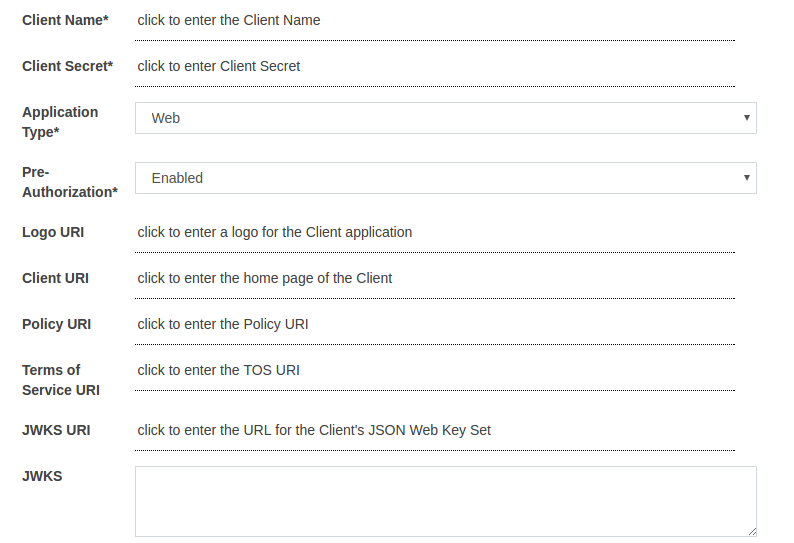
There are many client configuration parameters. Most of these are specified in the OpenID Connect Dynamic Client Registration specification.
There are two configurations params which can only be configured via oxTrust by an administrator. These include:
-
Pre-Authorization -- Use this if you want to suppress the end user authorization prompt. This is handy for SSO scenarios where the clients are your own (not third party), and there is no need to prompt the person to approve the release of information.
-
Persist Client Authorizations -- Use this option if you only want to prompt the end user once to authorize the release of user information. It will cause the data to be persisted under the person's entry in the Gluu LDAP server.
Custom Client Registration#
Using the Client Registration custom interception scripts, you can implement post-registration business logic. You have access to the data that the client used to register. You could validate data, populate extra client claim, or modify the scope registrations. You could even call API's to determine if you want to allow the registration at all. To access the interface for custom scripts in oxTrust, navigate to Configuration --> Custom Scripts --> Client Registration.
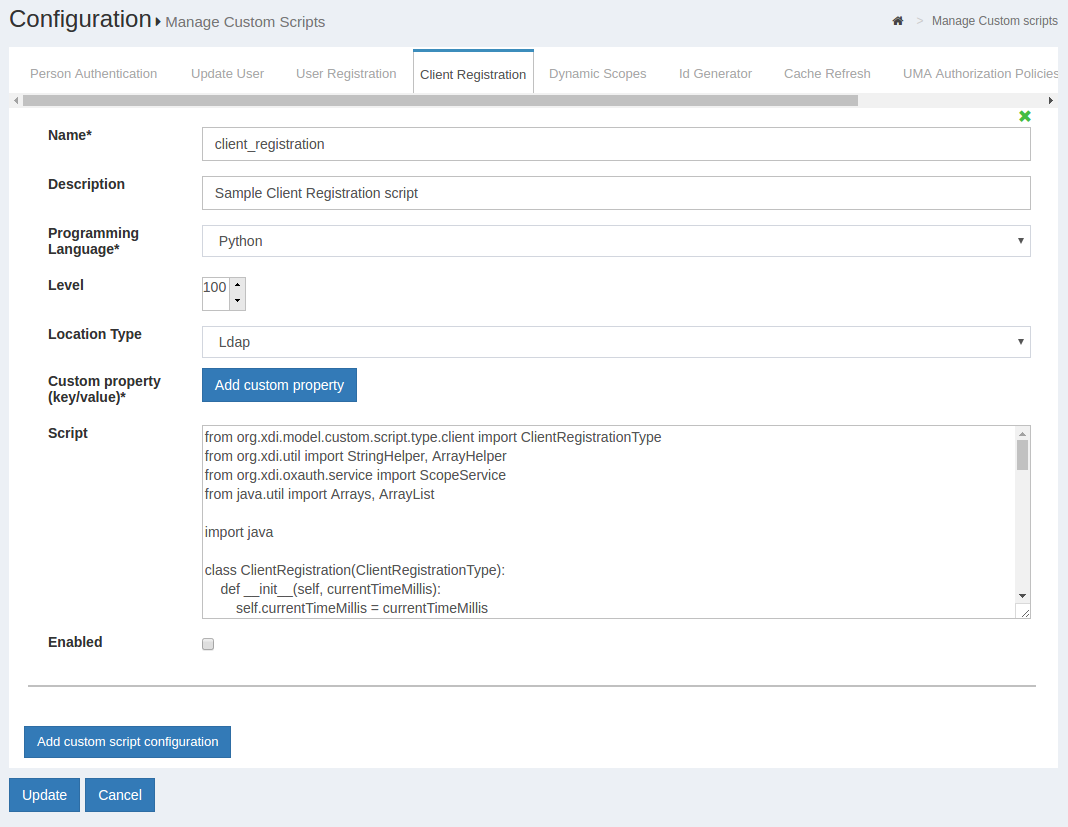
The script is available here
Scopes#
In OAuth, scopes are used to specify extents of access. For a sign-in flow like OpenID Connect, scopes end up corresponding to the release of user claims. The Gluu Server supports the standard scopes defined in the OpenID Connect specification. You can also define your own scopes, and map them to any user attributes which you have registered.
To add Scope and Claims in OpenID Connect
-
Click on
Configuration>OpenID Connect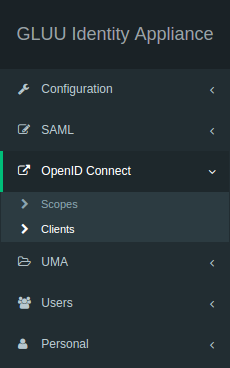
-
Click on Add scope on the screen to the right
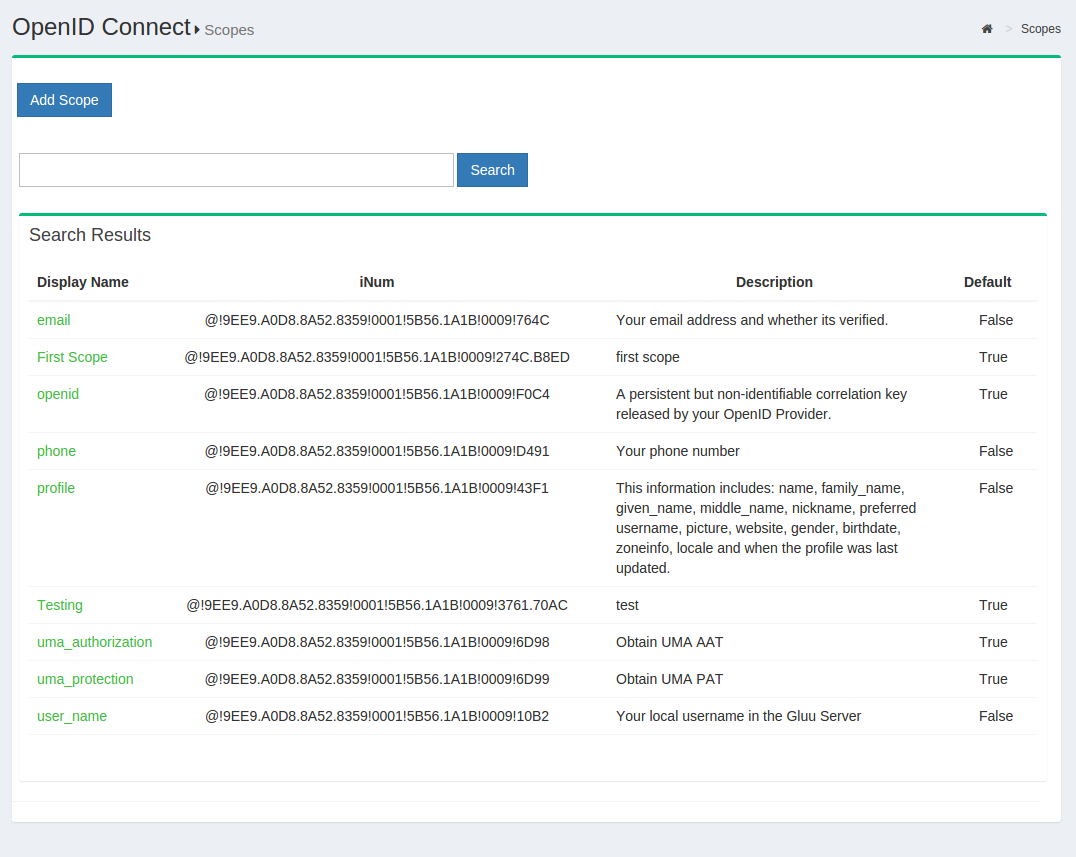
-
You will presented the screen below to the enter the Scope Details
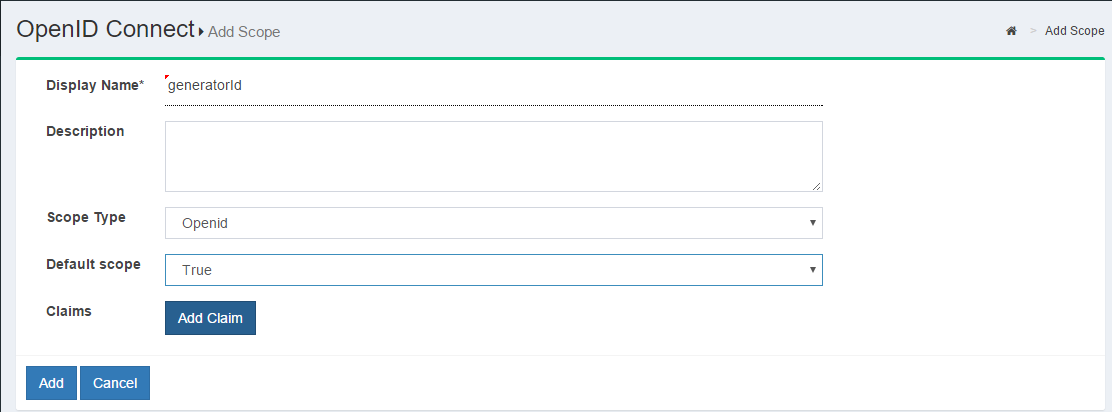
-
To add more claims, simply click "Add Claim" and you will be presented with the following screen:
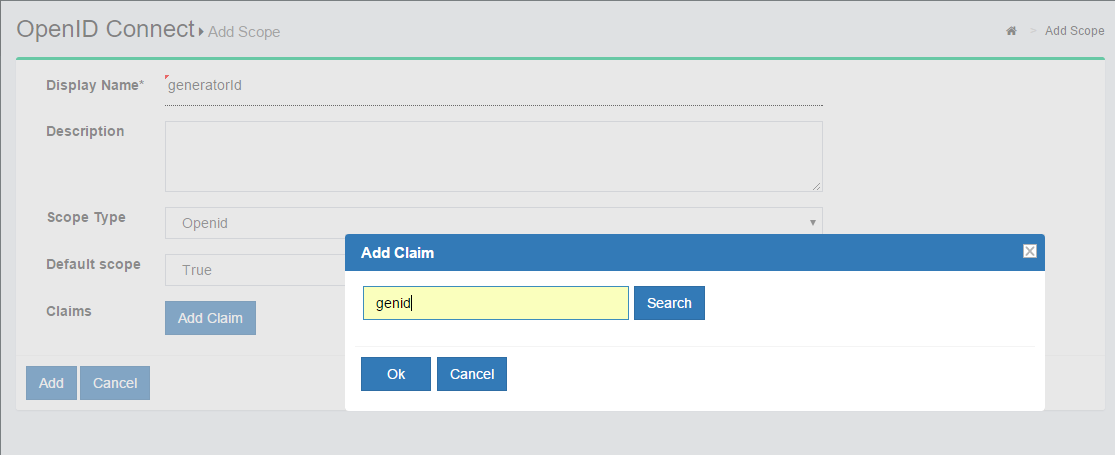
| Field | Description |
|---|---|
| Display Name | Name of the scope which will be displayed when searched |
| Description | Text that will be displayed to the end user during approval of the scope |
| Scope Type | OpenID, Dynamic or OAuth |
| Default Scope | If True, the scope may be added to clients' registrations created via Dynamic Client Registration protocol |
Scope Type "OpenID" specifies to the Gluu Server that this scope will be used to map user claims; "Dynamic" specifies to the Gluu Server that the scope values will be generated from the result of the Dynamic Scopes custom interception script; "OAuth" specifies that the scope will have no claims, it will be meaningful to an external resource server.
Specifying a scope as "Default" means that any OIDC client using Dynamic
Client Registration protocol is allowed to enlist it amongst scopes
that will be requested by RP(s) the client represents. As this may result in
sensitive users' data being leaked to unauthorized parties, thorough assessment
of all claims which belong to scopes about to be marked as "Default" is advised.
Right after the installation, the only default scope is openid,
which is required by the OpenID Connect specification. Gluu server's
administrator can always explicitly add additional scopes some client is allowed
to request by editing its registration metadata manually in web UI later on.
Multi-Factor Authentication for Clients#
The OpenID Connect acr_values parameter is used to specify a specific workflow for authentication. The value of this parameter, or the default_acr_values client metadata value, corresponds to the "Name" of a custom authentication script in the Gluu Server.
Out-of-the-box the Gluu Server includes custom authentiation scripts with the following acr values:
| ACR Value | Description |
|---|---|
| u2f | FIDO U2F Device |
| super_gluu | Multi-factor authentication |
| duo | Duo soft-token authentication |
| cert | Smart card or web browser X509 personal certificates |
| cas | External CAS server |
| gplus | Google+ authentication |
| OTP | OATH one time password |
| asimba | Use of the Asimba proxy for inbound SAML |
| twilio_sms | Use of the Twilio Saas to send SMS one time passwords |
| passport | Use of the Passport component for social login |
| yubicloud | Yubico cloud OTP verification service |
| uaf | experimental support for the FIDO UAF protocol |
| basic_lock | Enables lockout after a certain number of failures |
| basic | Sample script using local LDAP authentication |
To use any of these acr_values, login to your Gluu Server admin interface and navigate to Configuration > Manage Custom Scripts. Find the desired script, tick the Enabled check box, scroll to the bottom of the page and click Update. Learn more in the authentication guide.
Logout#
The OpenID Connect Session Management specification is still marked as draft, and new mechanisms for logout are in the works. The current specification requires JavaScript to detect that the session has been ended in the browser. It works... unless the tab with the JavaScript happens to be closed when the logout event happens on another tab. Also, inserting JavaScript into every page is not feasible for some applications.
The Gluu Server also support the draft for Front Channel Logout. This
is our recommended logout strategy. Using this mechanism, an html page is rendered which contains one iFrame for each application that
needs to be notified of a logout. The Gluu Server keeps track of which clients are associated with a session (i.e. your browser). This
mechanism is not perfect. If the end user's web browser is blocking third party cookies, it may break front channel logout. Also, the Gluu Server has no record if the logout is successful--only the browser knows. This means that if the logout fails, it will not be logged or retried. The good thing about front channel logout is that the application can clear application cookies in the end user's browser. To use front channel logout, the client should register logout_uri's, or frontchannel_logout_uri for clients using the Dynamic Client Registration API.
OpenID Connect Relying Party (RP)#
In order to leverage your Gluu Server OpenID Provider (OP) for central authentication, your web and mobile apps will need to support OpenID Connect. In OpenID Connect jargon, your app will need to act as an OpenID Connect Relying Party (RP) or "client".
There are many ways to go about supporting OpenID Connect in your apps, however we do not recommend writing your own OpenID Connect client. Rather, it is best to use existing client software implementations that have been verified to implement OpenID Connect properly (and securely!). A good OpenID Connect client will do much of the heavy lifting for you.
Note
Although you can use generic OAuth client libraries, you would have to write some extra code to take advantage of the security features baked into OpenID Connect. For example, there is no id_token in OAuth, so you won't find any code for id_token validation in an OAuth library.
Single Page Applications#
To support OpenID Connect in a single page application (SPA), we recommend using Identity Model's OpenID JS Client.
You'll have to add the client manually to the Gluu Server via the GUI.
When completing the add client form, you can use the following
configuration:
Client Name: Implicit Test Client
response_type: token id_token
Application Type: Web
Pre-Authorization: Enabled
Subject Type: public
Scopes: openid, profile, email
Response Types: token id_token
Grant Types: implicit
Once you have registered the client in the Gluu Server, all you need to
do is update the client_id, redirect_uri, and providerInfo values
in the login page html. Assuming you've checked out the project into a
web accessible folder, then navigate to the page and test!
Server-Side Web Applications#
Many applications are "server-side", meaning the web page displays content but most of the dynamic business logic resides on the web server. Two design patterns have emerged for securing server-side web applications: (1) use of web server filters and reverse proxies, and (2) leveraging OAuth2 directly in your application. Which approach to use depends on the trade-off between easier devops (option 1), and how deeply you want to integrate centralized security policies into your application (option 2).
Add OpenID Connect in the Application#
Calling the OpenID Connect API’s directly will enable “smarter” applications. For example, transaction level security can be more easily implemented by calling the APIs directly. This can have a positive impact on usability. Giving developers more ability to leverage centralized policies may also increase re-use of policies, and ultimately result in better security.
The OpenID Foundation maintains a list of client libraries on their website. However, our experience has been that the quality of these libraries varies widely. Some are not well documented, other are not updated frequently, and some do not implement essential security features available in OpenID Connect. In addition, if a wide array of client libraries are used it becomes difficult to monitor and patch security vulnerabilities.
For these reasons, we recommend using our OpenID Connect middleware software called oxd to secure and integrate web applications with your Gluu Server.
oxd is not open source software, but it is very reasonably priced. The code is available on GitHub. There are libraries available for PHP, Java, Python, C#, Node, Ruby, Perl and Go. There are also plugins available for several popular open source applications.
Use Web Server Plugins#
Web Server filters are a tried and true approach to achieving single sign-on with web applications. The web server filter enforces the presence of a token in a HTTP Request. If no token is present, the Web server may re-direct the person, or return a meaningful code or message to the application. The web server with the filter may directly serve the application, or may proxy to a backend service.
One of the advantages of the web server filter approach is that the application developer does not need to know that much about the security protocols--if the request makes it through to the application, the person has been authenticated and the request is authorized. Another advantage is that the application security is administered by the system administrators, not by developers. For example, it may be easier to manage and audit apache configuration than to read a bunch of code.
Apache Filter#
One of the best OpenID Connect relying party implementations was written by Hans Zandbelt, called mod_auth_openidc. It is an authentication and authorization module for the Apache 2.x HTTP server that authenticates users against an OpenID Connect Provider (OP). The software can be found on GitHub and is included in the package management system for several Linux distributions. There are binary packages available, and if you are good at compiling C code, you can build it yourself from the source.
Nginx Filter#
If you are an Nginx fan, there is a similar Lua implementation to make NGINX operate as an OpenID Connect RP or OAuth 2.0 RS.
Mobile Applications#
One of the most compelling reasons to use Connect is to authenticate people from a mobile application. The IETF draft OAuth 2.0 for Native Apps provides an overview of an improved design for mobile security. In addition to the security features of OpenID Connect, this draft suggests the use of a PKCE and custom URI schemes (i.e. an application can register a URI such as myapp:// instead of https://).
In 2016, Google released and then donated code to the OpenID Foundation called AppAuth for Android and iOS. The AppAuth projects also include sample applications. Simulataneously, Google announced that it was deprecating the use of WebViews--a strategy used by mobile app developers which is vulnerable to malicious application code. Not only does AppAuth provide secure authentication, it enables SSO across the system browser and mobile applications. It accomplishes this by leveraging new operating system features that enable the system browser to be called by an application in an opaque view that does not enable an app developer to steal a person's credentials, or other applications to steal codes or tokens. Using this approach, mobile app developers can use the authorization code or hybrid flow (as described earlier).
The Gluu Server is the only free open source OpenID Connect Provider that currently supports AppAuth.
oxAuth RP#
The Gluu Server ships with an optional OpenID Connect RP web application,
which is handy for testing. It's called oxauth-rp. During Gluu Server
setup, you'll be asked if you want to install it--which you should on
a development environment. It will be deployed on https://<hostname>/oxauth-rp.
Using this tool you can exercise all of the OpenID Connect API's,
including discovery, client registration, authorization, token,
userinfo, and end_session.